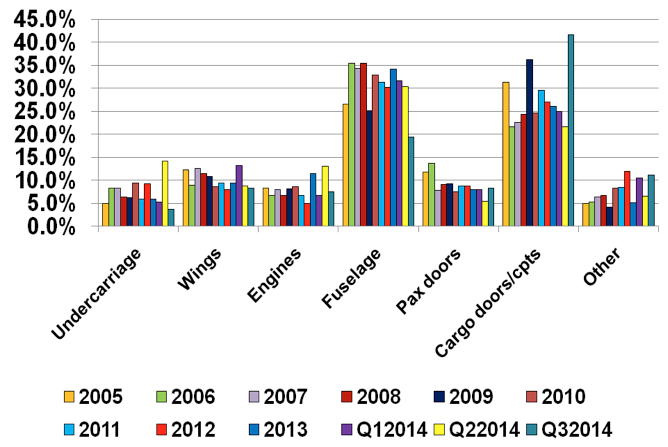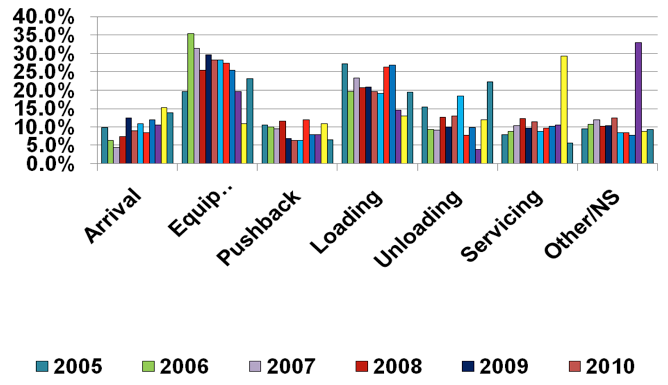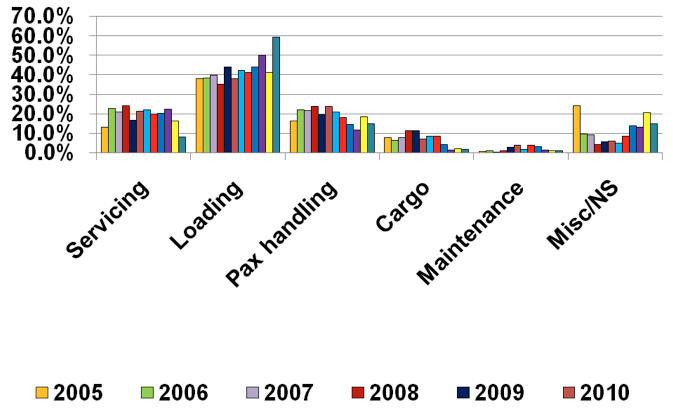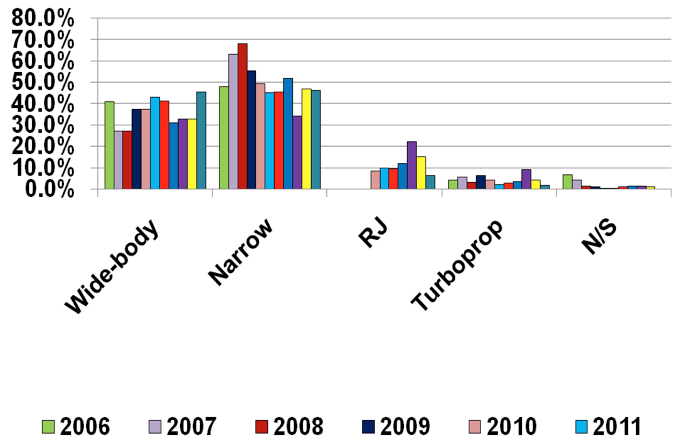Airport ground handling – industry overview 2014. Part 1: Liberalisation, efficiency & compensation
Long considered, perhaps unfairly, to be the 'bottom feeder' of the air transport business, the global airport ground handling business is now estimated to be worth over USD80 billion per annum according to its trade association, ASA - while some say USD100 billion.
By comparison the airline industry turned over around USD700 billion in 2013.
Ground handling's status may be growing but this particular business segment has unique issues that frequently dominate its agenda.
Part 1 of this report deals with the impact of liberalisation, the counter-intuitive inefficiency of multiple ground handlers and the recent UK Supreme Court's potentially disruptive decision on claims for delayed flights. Part 2 will review the consolidation of the ground handling industry and emerging alliances.
Ground handling broadly comprises all those services required by an aircraft between landing and take-off (for example the marshalling of aircraft, loading/unloading, refuelling, baggage handling, passenger handling, aircraft maintenance and so on). An airline may choose to provide services for itself (self-handling), or to contract with another company (outsourced/third party handling), be it an airline or a dedicated ground handling company.
Interestingly, regulatory scrutiny is disparate; globally from ICAO, regionally from FAA & EASA, nationally from NAAs, as well as separately from environment and health, life safety and corporate governance
One notable change in the ground handling business is a growing propensity towards outsourcing by the airlines. This is in line with carriers' desire increasingly to segment the market and processes in order to drive up ancillary revenues (e.g. cabins, baggage), as well as outsourcing non‐core activities (station management, ground handling, especially outside 'home territories') and thereby adding greater complexity to ground operations.
IATA conservatively estimates that airlines outsource more than 50% of the ground handling that takes place at the world's airports to third party or non-airline handlers. This percentage is expected to grow as more and more airlines realise the financial benefits of outsourcing this operational component.
Ground Handling at larger European airports still adjusting to the consequences of greater liberalisation
This trend is somewhat dependent on legislation both to facilitate and to stimulate outsourcing and has been increasingly prevalent in Europe. It was previously highlighted in a CAPA report in Oct-2011.
See related report: Handle with care - Europe's airport ground handling business to be liberalised further
In that report it was pointed out that at one time ground handling was probably the least competitive business segment within the airports sector in Europe. Prior to the ground handling Directive 96/97/EC, only 7% of ground handling was undertaken by independent handlers, but due to the liberalisation of the market opened up by the Directive, that had risen to 45%. Even then, the top 10 operators do not handle 10% of the business, resulting in pressure across the EU to open up airport handling services to more competition.
Slowly but surely however, it has been liberalised to the point where European airports with greater than 15 million passengers per annum are expected to allow at least two core ground handling providers (including their own, if they choose to indulge in that activity, or that of a dominant airline) and two self-handlers. The European Commission (EC) was on the verge of compelling airports to allow at least three such providers, theoretically to increase further competition and to improve service standards.
While the EC did at least introduce a social dimension into its proposal - it would aim at a gradual increase of competition in the ground handling market while taking into account appropriate social protection of ground handling staff - airport trade body ACI Europe was not keen on the idea. It argued at the time that "it is instructive to know that airport revenues from ground handling plunged 20% between 2009 and the preceding year. Overall, airports now represent only around 15% of this particularly competitive market.
This not only highlights the far-reaching impact of the current Directive. It also suggests that existing competitive pressures are such that a further opening of the market risks its fragmentation, and in the process jeopardises the efficiency and quality of ground handling operations at many airports."
The lengthy processes of the European Parliament mean that the EC's proposals on this matter are still under review at the time of writing. The Airport Package is still scheduled to be finalised in 2014 but that seems increasingly questionable.
ACI Europe continues to make the case that the market is already largely open in most of Europe, and that further expansion of the EC's requirement for additional 'choice' would only have a limited impact.
Consultant argues that opening the market means more scale economies will be lost
A report prepared by ground handling specialist the Chris Smith Aviation Consultancy in Nov-2013 argued that further opening of the market is likely to have the opposite effect as turnaround processes will have been improved and optimised, labour costs and working practices have been squeezed tight and further scale economies will be lost. Scale economies are driven by airline schedules.
A typical large European airport handling 15 to 20 million ppa has over 200 departures each day with a turnaround duration of 30 minutes and the aircraft are mainly Code c types to short-haul destinations. There will be eight airlines or more. The crucial point is that their peaks usually do not coincide.
THEIR PEAKS DO NOT COINCIDE |
The problem is, as Dr Smith demonstrated, that productivity decreases in proportion to the growing number of handlers. The more handlers there are, the more ground support equipment (GSE) is needed. For a single service provider, 16 units are required. For two handlers (the current position) 24; and three handlers would mean a requirement for 29 units. That translates into a 20% reduction in scale economies in what is already a heavily marginalised business.
Pooling of equipment and labour might be the answer
One possible solution he put forward is of 'pools' of both GSE and of labour, the latter being a more challenging proposition. In the case of GSE the pool would include the airport operator; a consortium of ground handlers; a financial institution(s); and aircraft lessors or parts suppliers. The main benefit would be retention of current scale economies and a return to 'Single Provider' efficiency.
A labour pool would be justified by the fact that similar scale inefficiencies apply to labour in the event of more ground handling suppliers. Quantifying staff needed for a Code C turnaround over two shifts, Smith identified 28 crews required by a single provider, 40 in the event of two handlers (the current position) and 47 for three handlers; again a 15-20% reduction in scale economies.
In conclusion, Dr Smith said that it is highly probable that the new EU Regulation will require a further opening of the ramp market and that even if it does not, the previous (1996) Ground Handling Directive resulted in a significant loss of scale economies. A dynamic GSE Pool would allow these scale economies to be regained, in addition to having other advantages. A Labour Pool would generate even greater cost savings, but would come with much bigger challenges. Each Pool could cut costs by a third. However, without one or both pools, the further loss of scale economies can only be off‐set by:
- Further improvements in turnaround processes: But is there anything left to improve?
- Further reduction in unit labour costs and deterioration of working practices: Can staff be squeezed further without greater compromise of safety and security?
- Increasing costs to the airlines: But can they afford it?
The ultimate question is the most telling: Are the Ground Handling and Airline industries so wealthy that they can afford not to seriously study the introduction of Pools?
To summarise this section briefly, the EC's proposals to increase the number of ground handlers at major airports has not exactly met with universal approval and this has repercussions for any similar scheme in other parts of the world.
It goes without saying that airlines are in favour of greater choice in order to increase competition among providers, drive down costs for operators and increase quality for passengers and the European Regional Airlines Association (ERA) believes the number of independent handlers at many airports is still very limited. However, it adds that care must be taken to ensure that the benefits the Commission proposes are not eroded by additional new administrative burdens.
No fixed global template for Ground Handling activities
The CAPA report referred to earlier also went on to say that there is no fixed template across the world for ground handling activities and that remains the case today. Regulations vary widely across the globe, often based on historic pretext as in the US, or driven by the feverish desire to enhance competition that is often found in pan-national political and trading blocs such as the EU.
There are universal truths about ground handling though and one of them is that it is a highly specialised activity with high quality security equipment for baggage and cargo handling especially. Costs are often in stark contrast to low profit margins. Speed, efficiency and accuracy are important in ground handling operations in order to minimise turnaround time and handling costs; the industry is under constant pressure from increased competition, rising passenger and cargo traffic and the price sensitivity of low cost carriers to produce these results.
That degree of speciality and the operational costs lie uneasily with the potential outcomes of ramp and apron accidents, one of the unique issues this part of the air transport business has to deal with, and one that tend to dominate the agenda at the segment's huge global conferences, one of which is taking place in Sweden in early Nov-2014.
For CAPA's unique comprehensive 280-page report on Ground Handling in India 2014, including airport by airport SWOTs, please see:
CAPA India Ground Handling Report 2014
The Ground Handling market is growing but margins are reducing as compensation payouts mount
As the trade association ASA (Airport Services Association) points out, while the ground handling services market is growing, ironically its handling margins have reduced over the last decade. Key contributing factors include an increase in handling licences issued by airports - especially in highly regulated markets such as European under the advisement of competition authorities as referred to above - and airlines availing themselves of the increased competition, further to drive down the handling contract price.
This scenario can lead to a race to the bottom and strained operations on the ramp. With the industry footing a damage bill to aircraft on the ground of approximately USD4 billion annually, further threats to ramp safety are a real worry to ASA. Human factors studies funded at European level are also under way in an attempt to reduce this figure.
The main areas of damage to aircraft
Phase of operation of incidents
Incidents by equipment type
Incidents by aircraft type
The figure of USD4 billion is questioned by Tim Ornellas, of the analyst Ground Handling International, who considers it has no foundation. While IATA insists the figure is nearer to USD10 billion - one eighth of the segment's global annual turnover - Mr Ornellas points out that includes consequential losses to passengers and to companies awaiting the delivery of goods.
Such cost estimates can easily become wrapped up with those for compensation for flight cancellations and delays under such jurisdictions as those within the EU for example, where recent court rulings have enabled and encouraged passengers to make back-dated claims for costs such as accommodation and sustenance for periods of up to six years.
UK airlines rocked by court decision on delayed flight claims
In the UK for example, a recent Supreme Court decision will allow passengers to claim up to six years after a delayed flight, and will force airlines to pay compensation even when aircraft are held back due to routine mechanical or electrical problems. Such incidents could open the door to more than two million compensation claims every year in the UK alone, worth an estimated GBP876 million. The decision will also open airlines to historic claims from passengers dating back to 2008, which could be worth another GBP4 billion.
Passengers are entitled to up to GBP470 (EUR600) each, depending on the length of the flight, plus expenses when their arrival is delayed by more than three hours and the cause of the disruption is within the carrier's control. That is more than twice the average low cost airline ticket price.
If such rulings are not successfully challenged - and so far that has not been the case - then there will be even more pressure on the ground handling segment to avoid incidents that delay aircraft departures.
Complications can arise out of the use of more sophisticated technologies by airframe manufacturers and the segment anticipates claims cost might rise even higher as a result. Paramount among them is the use of new generation composite technology. Bumping a ground service vehicle into a parked aircraft has always been a potentially costly affair, but it is even more so when the damage is not as readily observable as it used to be with aluminium frames, as is sometimes the case with the B787 according to those familiar with these technologies.
As the industry can expect to see more new generation technology, for example in the A350, the first Airbus with both the fuselage and wing structures made primarily of carbon fibre reinforced polymer, this is a yet another problem that requires urgent attention.
This is not the first time new technologies have caused problems for ground handling activities of course. Before the B787 the industry had to rise to meet the challenge of servicing the handling needs of a new breed of large capacity aircraft - the A380. The use of Multi Aircraft Ramp Systems were particularly effective in the highly traffic congested airports the A380 was initially deployed at, to the extent that the design target of a 90 minute turnaround time was often achieved.
By and large, handling the A380 is no longer considered problematic and with no new large aircraft under construction beyond the B787 and A350 variants, the B747-8 (which is often used in its freighter version) and the B777-X, more attention can now be paid to the avoidance of costly accidents involving carbon fibre structures.
Other factors that are not related to aircraft types include:
- Service equipment innovations such as TaxiBot (an Israeli semi-robotic pilot-controlled taxiing vehicle that avoids the need to use the aircraft's own engines and which was cleared for use by the by the European Aviation Safety Agency [EASA] in the first week of Nov-2014); Wheel Tug (a nosewheel-mounted motor and drive powered by the aircraft's APU) and Green Taxi, a similar e-taxi apron device;
- Other alternative environmentally friendly power sources emerging;
- Service equipment often not being maintained with the same rigour as aircraft;
- Aircraft and airport design not taking account of ground operations.
Human factors + litigation = even more costs
But quite apart from the financial costs there are also the human costs, and the consequential lingering threat of litigation both against individuals and by them.
Human factors influencing performance of activities in the ramp area have acquired proportionately more significance then they have in most other fields of the air transport industry, with the obvious exceptions of cockpit flight crew and airport security staff. Human behavioural factors are allocated at least as much weight as are organisational/systemic ones in training programmes and embrace, inter alia:
- The perceptual, mental, physical capabilities of people;
- The interaction of individuals with their jobs and working environments;
- Influence of equipment and system design on human performance;
- Organisational characteristics which influence safety‐related behaviour at work.
It is perhaps of little surprise that most of one afternoon of the segment's biggest conferences in 2013 was taken up by an interactive performance involving professional actors relating to a serious industrial accident at a chemical plant in the United States some years ago, and the subsequent discussion concerning the mistakes made by some of the individuals and how they could have been avoided.
Moreover, a further presentation at the same event examined an injury claim made by an experienced ground handling operative working at an airport in the north of England. Despite his experience he injured his knee manoeuvring inside the hold of an aircraft belonging to a major US carrier, attempting to dislodge a unit load device (ULD) that had got stuck. This caused him to take two months off work and to seek compensation.
The main allegations made on both sides included:
- Failure to train
- Failure to provide suitable work equipment
- Failure to provide assistance
- Failure to provide competent fellow employees
- Failure to provide a safe system of work
- Pressure to work quickly
- Pressure to work alone (cheaper for the GH company and the airline)
- Cutting corners accepted - a blind eye is turned
- "Getting the job done" overrides safety
The outcome ultimately hung on a dispute between the airline and the ground handling company as to which had responsibility for training staff working on that aircraft; and for defects in aircraft equipment. In the judgement, both the airline and the ground handling company were found to be liable. The judge stressed how both sides have shared responsibilities and it is difficult to divide them and it was suggested that shared insurance policies and costs might be a potential solution.
The 'punchline' in this case is that the claimant lost his case as the medical records unearthed by the defendants proved that the claimant suffered his injury prior to the alleged accident
Even so, the costs to both the ground handling company and the airline were formidable: a total of 16 working days lost attending the trial without taking into account legal fees; and none of it recoverable. There are many such examples in the industry, which emphasises the relative paucity of its finances.
Part 2 of this report will review the consolidation of the ground handling industry and emerging alliances






